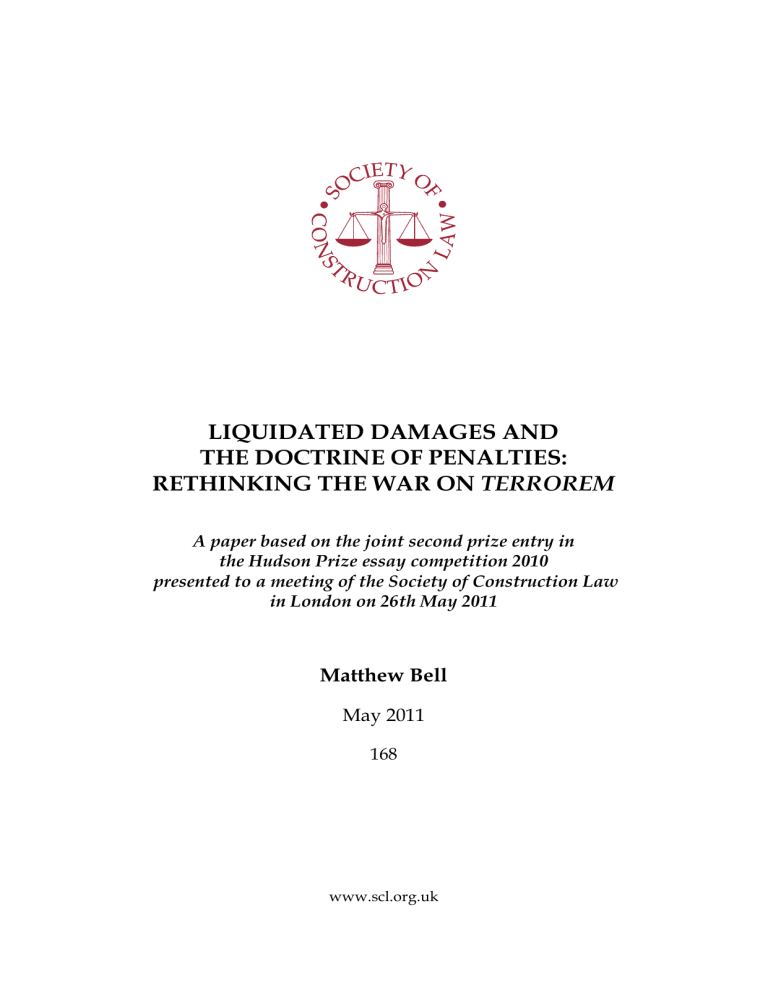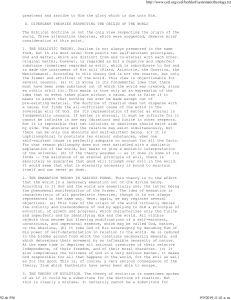
LIQUIDATED DAMAGES AND THE DOCTRINE OF PENALTIES: RETHINKING THE WAR ON TERROREM A paper based on the joint second prize entry in the Hudson Prize essay competition 2010 presented to a meeting of the Society of Construction Law in London on 26th May 2011 Matthew Bell May 2011 168 www.scl.org.uk LIQUIDATED DAMAGES AND THE DOCTRINE OF PENALTIES: RETHINKING THE WAR ON TERROREM Matthew Bell A. Introduction It is the underlying premise of this paper that, where commercial parties have freely agreed, within a binding contract, to a regime for liquidated damages („LDs‟) which is expressed in terms sufficiently certain to be enforced, the law should uphold its enforcement upon those terms. Such a notion serves a desirable commercial purpose in that it allows parties to anticipate with maximal certainty the remedial consequences where the contract is breached. It is also consistent with the underlying rationale for the enforcement of contracts which seeks to ensure that obligations are undertaken freely and, once such voluntariness is established, allows for minimal interference by the courts.1 English courts have for many years sought to act in a manner consonant with this rationale. As was observed by Lord Woolf, for example, „... the court has to be careful not to set too stringent a standard and bear in mind that what the parties have agreed should normally be upheld. Any other approach will lead to undesirable uncertainty especially in commercial contracts.‟2 In turn, the modern approach places a high barrier in the path of a party seeking to overturn an LDs provision on the basis that it is penal. It looks to whether „the predominant contractual function of the provision was to deter a party from breaking the contract or to compensate the innocent party for breach.‟3 Even where a penal intent is discerned, the court may have regard to whether the provision is, nonetheless, „commercially justifiable‟.4 However, the jurisprudential foundations of the penalty doctrine remain, in the words of appellate-level judges, „anachronistic‟,5 „pragmatic rather [than] 1 2 3 4 5 See, generally, Andrew Robertson, „The Limits of Voluntariness in Contract‟ (2005) 29 Melbourne University Law Review 179, page 182. Philips Hong Kong Ltd v Attorney-General of Hong Kong, (1993) 61 BLR 41, pages 589 and (1993) 9 Const LJ 202 (PC). Lordsvale Finance plc v Bank of Zambia [1996] QB 752, page 762G (and [1996] 3 WLR 688), cited by Arden LJ in Murray v Leisureplay [2005] EWCA Civ 963, para [106]. The relevant authorities, stemming from Lordsvale Finance (note 3), are discussed by, for example, Paula D Baron, „The Doctrine of Penalties and the Test of Commercial Justification‟ (2008) 34 University of Western Australia Law Review 42, pages 52-55. Bridge v Campbell Discount Co Ltd [1962] AC 600 (HL), page 622 and [1962] 2 WLR 439 (Radcliffe LJ). 1 principled‟,6 and an „anomaly‟ within the law of contract.7 Thus, parties seeking legal advice as to the way in which they can frame their LDs provisions often receive it with „incredulity‟.8 From a commercial point of view, perhaps the most counter-intuitive aspect is that the law maintains a prohibition upon parties using LDs provisions to enforce performance by placing the other in fear – terrorem – of breach. This is especially difficult to rationalise in view of contemporary contracting approaches in the construction industry which embrace the potential for risk sharing and therefore assume that the parties are able to tailor a risk-reward scheme geared towards „best for project‟ outcomes.9 Indeed, whilst it has become common parlance in certain sectors for LDs to be regarded as a mechanism to „incentivise the [c]ontractor‟,10 it remains the case that a party cannot justify an LDs provision on that basis.11 This paper argues that the prohibition upon deterrence is an element of the doctrine of penalties which has outlived its usefulness. It does so within the following structure: o Part B describes the commercial impetus for the use of LDs provisions in construction contracts; o Part C outlines the history, and current state, of the law relating to deterrence within the penalty doctrine; o Part D offers a critique of the current law; and o Part E proposes, by way of conclusion, an alternative formulation of the doctrine of penalties based upon whether the allegedly penal component serves a purpose other than the proper performance of the contract. This paper focuses upon the position in England, with some reference to Australian case law and commentary. This is primarily for the sake of brevity but also because within each of these countries there has been significant consideration of the penalties doctrine by the courts in recent years. 12 Having 6 7 8 9 10 11 12 Murray: note 3, para [29]. Alfred McAlpine Capital Projects Ltd v Tilebox Ltd [2005] EWHC 281 (TCC), para [48]; also [2005] BLR 271, 104 Con LR 39, 21 Const LJ 539. Michael Furmston, „Contract Planning: Liquidated Damages, Deposits and the Foreseeability Rule‟ (1991) 4 Journal of Contract Law 1, page 7. See, for example, Arent van Wassenaer, „In Search of the Perfect Project: Incentivising Performance and Collaboration in Construction Projects through Key Performance Indicators‟ (2010) 27 ICLR 336 and Philip Loots and Nick Henchie, „Worlds Apart: EPC and EPCM Contracts: Risk Issues and Allocation‟ (2007) 24 ICLR 252, page 253. See, for example, Office of Government Commerce, „Contract Management in LongTerm or Complex Projects: Key Commercial Principles to Help Ensure Value for Money‟ (London, 2010), page 7 <www.ogc.gov.uk> Hugh Beale (general editor), Chitty on Contracts (30th edition Sweet & Maxwell, London 2008), para 1681. For general commentary, see, for example, Paula D Baron: note 4; J W Carter and Elisabeth Peden, „A Good Faith Perspective on Liquidated Damages‟ (2007) 23 Journal of Contract Law 157; Cyril Chern, The Law of Construction Disputes (Informa Law, London 2010); Stephen Furst and Vivian Ramsey (editors), Keating on Construction Contracts (8th edition Sweet & Maxwell, London 2006); Michael Hollingdale, 2 said that, it is acknowledged that a very substantial body of case law and debate along similar lines exists in other countries, notably in North America.13 B. The commercial impetus for LDs in construction contracting LDs as a risk mitigation measure The common law and equitable principles governing the enforceability of LDs apply generally (though not necessarily uniformly) across commercial contracts. The principles find particular resonance and court particular controversy, however, in the field of contracting for construction work.14 Construction law texts, along with many detailed papers and articles, provide detailed commentary upon the principles and their application.15 Moreover, almost invariably, the standard forms of construction contract in widespread use for domestic or international work provide for the use of LDs as a default position.16 13 14 15 16 „Designing and Enforcing Liquidated Damages Clauses to Maximise Recovery‟ (2005) 21 Building and Construction Law Journal 412; Hamish Lal, „Liquidated Damages‟ (2009) 25 Construction Law Journal 569; Elizabeth V Lanyon, „Equity and the Doctrine of Penalties‟ (1996) 9 Journal of Contract Law 234; Patrick Mead, „Liquidated Damages – The Law of Penalties‟ (2007) 19(8) Australian Construction Law Bulletin 86; Rachel Mulheron, „Nine Lives for a Contractor to Avoid or Reduce Liquidated Damages‟ (1998) 61 Australian Construction Law Newsletter 18; Solene Rowan, „For the recognition of remedial terms agreed inter partes‟ (2010) 126 LQR 448; John Uff, Construction Law (10th edition Sweet & Maxwell, London 2009); Richard Wilmot-Smith, Construction Contracts: Law and Practice (2nd edition OUP, Oxford 2010). This is summarised by Paula D Baron: note 4, page 46. See also, for example, Deborah S Coldwell, Altresha Q Burchett-Williams and Melissa L Celeste, „Liquidated Damages‟ (2010) 29 Franchise Law Journal 211 and, on jurisdictions other than the USA, R Bruce Reynolds, „The Common Law Enforceability of Exculpatory Provisions in Canadian Construction Contracts: The Divination Of Intent – The Primacy of Commercial Reasonability‟ (2004) ICLR 402; Norman S Marsh, „Penal Clauses in Contracts: A Comparative Study‟ (1950) 32 Journal of Comparative Legislation and International Law 66; Herbert Smith, „Liquidated Damages: A Note of Caution‟ Asia Construction eBulletin October 2010 <www.herbertsmith.com>; Virginie Colaiuta, „Acceleration of works and penalties for delay in France in construction projects‟ [2010] ICLR 268; Said M Hanafi, „Contractors‟ Liability under the Civil Codes of Algeria, Egypt, Qatar and the UAE‟ (2008) 25 ICLR 220. John Hamilton Baker, An Introduction to English Legal History (4th edition Butterworths, London 2002), page 326. See, for example, Ellis Baker, Ben Mellors, Scott Chalmers and Anthony Lavers, FIDIC Contracts: Law and Practice (Informa Law, London 2009), page 413; Chitty: note 11, page 1681; Cyril Chern: note 12, page 251; Nicholas Dennys, Mark Raeside and Robert Clay (eds), Hudson’s Building and Engineering Contracts (12th edition Sweet & Maxwell, London 2010) sections 6-022 to 6-023 and 6-044 to6-050; Keating: note 12, page 308; Philip Loots and Donald Charrett, Practical Guide to Engineering and Construction Contracts (CCH, Sydney 2009), pages 154-5; Keith Pickavance, Delay and Disruption in Construction Contracts (4th edition Sweet & Maxwell, London 2010), pages 1205; Construction Law: note 12; Construction Contracts: Law and Practice: note 12, page 213. See, generally, Delay and Disruption in Construction Contracts: note 15, page 1206; Michael Hollingdale: note 12, page 415; FIDIC Contracts: Law and Practice: note 15, chapter 26; and, in respect of the FIDIC „Silver Book‟ form, Joseph A Huse, 3 This widespread use of LDs may be seen as reflecting the „good business sense‟ of seeking up-front certainty of remedial outcomes by avoiding the exigencies of court or arbitral processes.17 This benefit has been recognised since at least the late eighteenth century,18 and potentially applies to both the employer and the contractor and also throughout the contractual chain.19 Indeed, it has been proposed that the benefits of LDs extend beyond the parties, with economic efficiency being broadly promoted through resources being put into up-front negotiation rather than litigation.20 Specifically, parties seek to gain certainty at the start of the project as to (in the case of those doing the work) their potential liability and (in the case of those for whom the work is done) their ability to recover in the event that the default the subject of the clause is triggered. Most often in construction contracting, this is failure to complete the work within the required period but, conceptually, LDs may be applied to any breach.21 Parties are, therefore, seeking to rely upon the twin assumptions underpinning the legal principles: o first, that, where enforceable, liquidated damages will provide a limitation upon the claimant‟s right of recovery (that is, the LDs set a cap upon damages for that event such that the claimant cannot claim compensation at general law for its losses to the extent they exceed the applicable LDs); and o second (and conversely), that the claimant is entitled to recover LDs in accordance with the contractual mechanism even where its actual losses in the circumstances are less than the amount available as LDs.22 Moreover, the losses recoverable by way of liquidated damages may exceed those which would otherwise be legally recoverable – for example, they may 17 18 19 20 21 22 Understanding and Negotiating Turnkey and EPC Contracts (2nd edition Sweet & Maxwell, London 2002), page 63. Robophone Facilities Ltd v Blank [1966] 1 WLR 1428 (CA), page 1447 (and [1966] 3 All ER 128) (Diplock LJ). As was observed by Lord Ashurst in 1787 in relation to a contract for the iron work of a building, LDs may „prevent any altercation concerning the quantum of damages‟: Fletcher v Dyche (1787) 2 TR 32, as cited in William David Evans, „Appendix Illustrative of the English Law on the Subject‟ in Robert Joseph Pothier, A Treatise on the Law of Obligations, or Contracts (A Strahan, London 1806), page 83. See also Clydebank Engineering and Shipbuilding Co Ltd v Don Jose Ramos Yzquierdo Y Castaneda [1905] AC 6 (HL), page 11; JW Carter and Elisabeth Peden: note 12, page 157; I N Duncan Wallace, Construction Contracts: Principles and Policies in Tort and Contract (Sweet & Maxwell, London 1986). Construction Law: note 12, page 317. The point is also made by, for example, Rachel Mulheron: note 12, page 18; J W Carter, Elisabeth Peden and G J Tolhurst, Contract Law in Australia (5th edition LexisNexis Butterworths, Sydney 2007), page 875; and J W Carter and Elisabeth Peden: note 12, page 157. C J Goetz and R E Scott, „Liquidated Damages, Penalties and the Just Compensation Principle: Some Notes on an Enforcement Model and a Theory of Efficient Breach‟ (1977) 77 Columbia Law Review 554, page 578. This point is discussed by, for example, Hamish Lal: note 12, page 583. See for example Keating: note 12, page 308; Cyril Chern: note 12, page 252; J W Carter and Elisabeth Peden: note 12, page 871. 4 include losses which would be irrecoverable due to the operation of common law principles of remoteness or mitigation.23 The setting of LDs is, therefore, akin to other staples of the construction contracting landscape (such as lump sum rather than reimbursable remuneration and the use of limitations of liability) which seek, to the extent possible, to privilege up-front certainty as to outcomes over the gamble of leaving the parties to their general law rights in circumstances as they actually unfold during the contract. The employer may often pay a price for such certainty, through the contractor building a risk premium into its tendered prices;24 on the other hand, the employer might receive a lower price if it is willing to agree to LDs which are significantly less than its anticipated actual loss.25 The level of LDs which applies is a function not only of the relative bargaining strengths of the parties to that contract but also is influenced by factors operating generally within the relevant contracting sector or region. 26 Thus, LDs play a critical role in the overall risk/reward matrix applicable to construction contracts. In turn, parties acting in an economically rational manner in negotiating such contracts may reasonably hold an expectation that the law will – as it does, for example, in relation to whether the contract price represents adequate consideration – place minimal restrictions upon the legal enforceability of the bargain which is struck. Challenges to enforceability The benefit of up-front certainty, noted above, may well be generally understood and, to varying extents, held to at the time of entry into the contract. However, it tends to revert to an abstract concept when construction risks place the stipulated completion date in jeopardy. In these, all too frequent circumstances, the contractor may find that even a modest daily rate of LDs leaves it prima facie vulnerable to a substantial claim in the aggregate.27 On the other hand, the employer may find that the LDs available 23 24 25 26 27 Robert Stewart & Sons Ltd v Carapanayoti & Co Ltd [1962] 1 WLR 34 (Comm), page 39 (and [1962] 1 All ER 418, [1961] 2 Lloyd‟s Rep 387); Solene Rowan: note 12, page 456. Andrew Ham, „The Rule Against Penalties in Contract: An Economic Perspective‟ (1990) 17 Melbourne University Law Review 649, page 661. See also, for example, State of Victoria, Partnerships Victoria Guidance Material: Risk Allocation and Contractual Issues (Melbourne 2001), page 83. Keating: note 12, page 313. By way of recent example, Nick Henchie has noted that, during the Global Financial Crisis, the level of LDs which could be demanded by employers in the EPC sector increased both as to the number of weeks for which LDs could be levied and the overall cap as a percentage of the contract price: „Shifting Sands in the Economy and International Procurement Market‟ (2009) 26 ICLR 276, page 284. For example, a road building contract with LDs of A$8,000 per day resulted in a potential (and ultimately upheld) liability of approximately A$1.8M when the delay ran to seven months: see State of Tasmania v Leighton Contractors Pty Ltd (2005) 15 Tas R 243, page 245 (Slicer, Evans and Tennent JJ). 5 to it are substantially less than its actual loss.28 Inevitably, the legal enforceability of the LDs provision will then be put under scrutiny. It is important to recognise, as a starting point, the high commercial stakes which are bound up within the various tests as to whether a purported LDs clause is enforceable. As was noted by Buxton LJ, there is „no middle ground‟:29 the claimant will either be entitled to the entirety of the amount calculated by reference to the mechanism or left to prove its actual loss in accordance with the general law. There are, at least conceptually, many grounds on which the enforceability of LDs may be challenged under the general law.30 These include: o that the „prevention principle‟ applies in the circumstances to reduce or eliminate the claimant‟s right to damages;31 o that, as a matter of construction, the circumstances of default fall outside the provision or the term is void for uncertainty;32 or o through the operation of unfair contract terms legislation.33 Perhaps the most common ground on which the mechanism is challenged, however, is via the route which is the focus of this paper: the doctrine of penalties. C. Evolution of the doctrine of penalties Blair J in the English High Court recently remarked that the „law as to penalties is well settled‟.34 His Honour‟s statement is, with respect, entirely true: generally speaking, and as is reflected in the modern cases noted below, the key principles are applied in a fairly consistent manner. The fact the statement is able to be made is, however, remarkable because those principles are, to a substantial extent, based on less than solid legal foundations. Indeed, commentators have variously described the doctrine as a whole as presenting 28 29 30 31 32 33 34 See „Penalty or Liquidated Damages – Inadequacy of Stipulated Sum‟ (1931) 5 Australian Law Journal 93. Murray: note 3, para [109]. See generally, Rachel Mulheron: note 12; Michael Hollingdale: note 12: pages 417-422; Scott Laycock, „Liquidated Damages‟ (1996) 12 Building and Construction Law Journal 97, pages 99-102. Recent commentaries on this staple of the construction law diet include Ian Bailey, „Concurrency, Causation, Common Sense and Compensation (Part 2)‟ (2010) 27 ICLR 197 and A P Marshall, „Delay, Progress and Programming‟ (2010) 27 ICLR 137. This argument was successful in, for example, Arnhold & Co Ltd v Attorney-General of Hong Kong (1990) 47 BLR 129, (1989) 5 Const LJ 263 (High Crt of Hong Kong). See generally, Rachel Mulheron: note 12, page 27. Whilst the view remains that LDs clauses are not subject to the UK Unfair Contract Terms Act 1977 – see, for example, Chitty: note 11, page 1681 – it remains to be seen whether the revised consumer protection regime in Australia, under the legislative umbrella of the Australian Consumer Law (which is, in this respect, framed upon similar lines to the UK Unfair Terms in Consumer Contracts Regulations 1999), might open up possibilities in that country. Lansat Shipping Co Ltd v Glencore Grain BV [2009] EWHC 551 (Comm), para [17] and 2 All ER (Comm) 12, [2009] 1 Lloyd‟s Rep 541, 117 Con LR 88. 6 „a confused and contradictory state‟35 and its underlying rules as „a jumble of historical curiosities which out of context provide no unitary rationale‟.36 Pre-Dunlop history The law relating to penalties has long been recognised as being „obscure and not easily traced to any very exact source‟.37 Legal historians have, however, noted that source to be within Roman law,38 and that, in England, the doctrine grew out of the general prohibition, seated within canon law, against usury. Indeed, even after the Reformation and the dwindling of clerical influence upon the English courts, the Courts of Equity are said to have remained suspicious of „penal bonds‟, perhaps because they were brought to England by Italian bankers.39 By the end of the fifteenth century, it was common practice for the Chancery to grant an injunction preventing a creditor enforcing (via the courts of common law) the penal component of a bond, provided that the debtor discharged the debt as soon as possible and compensation was paid (by way of interest or otherwise) for the late payment.40 Three centuries later, the principle had crystallised, in a manner „too strongly established in equity to be shaken‟,41 that „wherever a penalty is inserted merely to secure the enjoyment of a collateral object, the latter is considered as the principal intent of the instrument, and the penalty only as accessory; and, therefore, only to secure the damage really incurred.‟42 Thus, the focus in this period was upon whether the penal component of the bond was to secure, not the due performance of the obligations under the bond, but a „collateral‟ purpose. In certain cases and commentaries there may be discerned an alternative justification for the prohibition. This was that, as expressed succinctly by Young LJ in 1881, „the law will not let people punish each other‟.43 This 35 36 37 38 39 40 41 42 43 Andrew Ham: note 24, page 650. G Muir, „Stipulations for the Payment of Agreed Sums‟ (1985) 10 Sydney Law Review 503, page 516. Joseph Story, Commentaries on Equity Jurisprudence as administered in England and America (Boston 1836), page 543. Commentaries on Equity Jurisprudence: note 37, page 549. See also Norman S Marsh: note 13, page 66. Frederick Pollock and Frederic William Maitland, The History of English Law Before the Time of Edward I (Cambridge, 1895), Volume 2, page 222; D E C Yale, „Introduction: An Essay on Mortgages and Trusts and Allied Topics in Equity‟ in Lord Nottingham’s Chancery Cases Vol II (Selden Society, London, Volume 79, 1961), pages 9-10; the latter (page 8) provides a detailed survey of the historical treatment of such bonds. This lack of sympathy carried through Elizabethan times (Shakespeare‟s portrayal of another Italian banker, Shylock, who sought enforcement of his „pound of flesh‟, was recalled by Pollock and Maitland, page 222). D J Ibbetson, A Historical Introduction to the Law of Obligations (OUP, Oxford 1999), page 213. See also Sydney Jacobs, Damages in a Commercial Context (Lawbook, Sydney 2000), pages 262-3. Sloman v Walter (1784) 1 Bro CC 418; 28 ER 1213 (Lord Thurlow), cited by William David Evans: note 18, volume 2, pages 74-5; Elizabeth Lanyon: note 12, page 238. Joseph Story: note 37, page 544. Lord Young in Robertson v Driver’s Trs (1881) 8 R 555, cited in Norman S Marsh: note 13, page 70. 7 philosophy holds that there is a distinction between democratically constituted legislatures imposing penalties upon individuals and corporations for a range of anti-social behaviours (the validity of such matters lies within fundamental principles of constitutional law44) and private citizens and corporations imposing penalties upon each other (which, as a matter of contract law, are not enforceable). Whilst this view retains some currency,45 it has received little attention in recent commentary and case law. This may well reflect a broader notion that, in commercial dealings at least, the line between private and public sector entities is increasingly being blurred.46 Perhaps taking their cue from Halsbury LJ‟s regarding it to be an „utterly unsound‟ proposition that damages could be levied for the non-delivery of a commercial ship but not a government warship,47 subsequent courts have rejected arguments that, for example, it is not possible for the public sector to suffer a loss which is capable of compensation by way of LDs.48 The Dunlop test On 28th June 1914, a shot rang out in Sarajevo, assassinating Archduke Ferdinand and precipitating events which were to change the course of twentieth century history. Three days later, in London, an event occurred which has had equivalent resonance within the (admittedly, somewhat more limited) sphere of the law of penalties: the House of Lords handed down its ruling in Dunlop.49 Whilst opinions were provided by each of the Law Lords – all allowing the appeal and therefore upholding the enforceability of the liquidated damages in question – it is that of Dunedin LJ which continues to form the bedrock of the law.50 It is almost invariably cited in subsequent commentary and cases on penalties,51 and the High Court of Australia, for example, has noted that 44 45 46 47 48 49 50 51 See for example, Joseph Story: note 37, pages 555-6. See, for example, Harold J Rosen and John R Regener Jr, Construction Specifications Writing: Principles and Procedures (5th edition John Wiley & Sons, New Jersey 2005), page 85; Cyril Chern: note 12, page 253. A recent example is the rejection by the High Court of Australia of an argument by the State of Victoria that the State should be excused from performance of a term of a contract negotiated by the Executive with a private-sector entity on the basis that the term effected a fetter upon the discretion of Parliament: Port of Portland Pty Ltd v Victoria [2010] HCA 44. Clydebank Engineering: note 18, page 13. See, for example, Tasmania: note 27, pages 260-2. See also the discussion by Elizabeth V Lanyon: note 12, page 239. Dunlop Pneumatic Tyre Company Ltd v New Garage and Motor Company Ltd [1915] AC 79 (HL). See, for example, Jeancharm Ltd v Barnet Football Club Ltd [2003] EWCA Civ 58, 92 Con LR 26, paras [9]-[10] (Jacob J). See, for example, Azimut-Benetti Spa v Healey [2010] EWHC 2234 (Comm), 132 Con LR 113, para [19]; Hamish Lal: note 12, page 571; Keith Pickavance: note 15, page 1209; Sydney Jacobs: note 40, page 257; Hudson: note 15, section 6-022; Richard Wilmot-Smith: note 12, page 214; Michael Hollingdale: note 12, page 413; Jeannie Paterson, Andrew Robertson and Arlen Duke, Principles of Contract Law (3rd edition Thomson Reuters, Sydney 2009), page 415; N C Seddon and M P Ellinghaus, Cheshire 8 Dunedin LJ‟s formulation has „endured … [and] been applied countless times‟.52 That Court has tended to regard it as something of a pole star to guide the law back to port on occasions when the lower courts allow it to drift off course.53 The seminal nature of Dunedin LJ‟s judgment rests upon his having identified and described four „authoritative‟ propositions in relation to the doctrine of penalties which aggregated the then existing law.54 These included (propositions 2 and 3): „The essence of a penalty is a payment of money stipulated as in terrorem of the offending party; the essence of liquidated damages is a genuine covenanted pre-estimate of damage … The question whether a sum stipulated is a penalty or liquidated damages is a question of construction to be decided upon the terms and inherent circumstances of each particular contract, judged of as at the making of the contract, not at the time of the breach.‟55 His Lordship went on to note various tests „[t]o assist this task of construction, which if applicable to the case under consideration may prove helpful, or even conclusive‟. These included that it „will be held to be a penalty if ...‟ „4(a) … the sum stipulated for is extravagant and unconscionable in amount in comparison with the greatest loss that could conceivably be proved to have followed from the breach …[or] 4(b) … the breach consists only in not paying a sum of money, and the sum stipulated is a sum greater than the sum which ought to have been paid.‟56 The citation of these two examples may be seen to mark the turning point in ascendancy of influence upon the basis for the doctrine between the (equitable) collateral purpose rationale (represented in 4(b)) and the (common law) compensatory notion (4(a)).57 This point had in fact occurred some substantial time before 1914 – indeed, a similar formulation and list of indicia to those of Dunedin LJ were described 52 53 54 55 56 57 & Fifoot’s Law of Contract (9th Australian edition LexisNexis Butterworths, Sydney 2008), page 1124; Elizabeth V Lanyon: note 12, page 242; J W Carter and Elisabeth Peden: note 12, pages 163-4; Paula D Baron: note 4, pages 46-8. Ringrow Pty Ltd v BP Australia (2005) 224 CLR 656, page 663 (Gleeson CJ, Gummow, Kirby, Hayne, Callinan and Heydon JJ). See, for example, the observations of the High Court of Australia in AMEV-UDC Finance Ltd v Austin (1986) 162 CLR 170, page 193 (Mason and Wilson JJ) and Esanda Finance Corporation Ltd v Plessnig (1988) 166 CLR 131, page 141 (Wilson and Toohey JJ) and page 149 (Brennan J). Dunlop: note 49, page 86. Hamish Lal has, for similar reasons, recently identified Jackson J‟s judgment in Tilebox as the „second seminal case‟: note 12, page 573. The cases underpinning Dunedin LJ‟s judgment are discussed by, for example, Adrian Baron, „Damages in the Shadow of a Penalty Clause – Tripping over Policy in the Search for Logic and Legal Principle‟ SCL Paper 101 (April 2002), pages 4-5 <www.scl.org.uk>; Hudson: note 15, section 6-045. Dunlop: note 49, pages 86-87. Dunlop: note 49, page 87. Hamish Lal: note 12, pages 235-6. 9 in 1850.58 One need look no further than the seminal judgment of Parke B in Robinson v Harman to observe that the compensatory model was well entrenched by the middle of the nineteenth century59 and, conversely, that the equitable jurisdiction had „withered on the vine‟.60 Nonetheless, it was Dunedin LJ who sounded the death knell of the collateral purpose rationale. Though he acknowledged it to be „one of the most ancient instances‟, he regarded it as subsumed by – „truly a corollary‟ to – the test in 4(a),61 and dismissed its historical development as „probably more interesting than material‟.62 That said, the collateral purpose rationale retains some resonance in modern case law. For instance, Diplock LJ referred to the need not to: „... offend against the equitable rule against penalties; that is to say, it must not impose upon the breaker of a primary obligation a general secondary obligation to pay to the other party a sum of money that is manifestly intended to be in excess of the amount which would fully compensate the other party for the loss sustained by him in consequence of the breach of the primary obligation.‟63 Current approaches to the deterrence element The two statements as to the „essence‟ of the doctrine set out in Dunedin LJ‟s proposition 2 above may be regarded, on their face, as having the potential to be mutually exclusive. However, subsequent consideration has confirmed that they form a double sided coin. In other words, consistent with the notion that both sides of the test rest upon a process of construction of the contract (proposition 3), the question of whether the offending party is placed in terrorem is not at large or to be determined subjectively. Instead, the analysis is generally by reference to the level of disproportion between the sum stipulated and the maximum conceivable loss (4(a)).64 The objective nature of the test has been emphasised, for example, by confirmation that the court will not look (under the umbrella of „unconscionability‟ referred to by Dunedin LJ) to whether the bargain itself is 58 59 60 61 62 63 64 John Adams, The Doctrine of Equity Being a Commentary on the Law as Administered by the Court of Chancery (London, 1850), pages 108-9. Robinson v Harman (1848) 1 Exch. 850. AMEV-UDC Finance: note 53, page 191 (Mason and Wilson JJ). Dunlop: note 49, page 87. Dunlop: note 49, page 87. See also A Historical Introduction to the Law of Obligations: note 40, page 214. Photo Production Ltd v Securicor Ltd [1980] AC 827, page 850. See, similarly, the statements of the High Court of Australia in O’Dea v Allstates Leasing System (1983) 152 CLR 359, page 383 (Wilson J) and Legione v Hateley (1983) 152 CLR 406, page 444 (Mason and Deane JJ), citing, inter alia, the 1722 judgment of Lord Macclesfield in Peachy v Duke of Somerset (1772) 1 Str 447 at page 453. Tilebox: note 7, para [48]. 10 unconscionable. Rather, as was noted by Lord Wright MR, „[i]t is merely a synonym for something which is extravagant and exorbitant‟.65 Thus, the modern approach rests upon using the ostensible „genuineness‟ of the pre-estimate as a proxy for whether the provision is a deterrent.66 This was succinctly described in the „more accessible paraphrase‟67 of the in terrorem notion suggested by Colman J in Lordsvale Finance: „… whether a provision is to be treated as a penalty is a matter of construction to be resolved by asking whether at the time the contract was entered into the predominant contractual function of the provision was to deter a party from breaking the contract or to compensate the innocent party for breach. That the contractual function is deterrent rather than compensatory can be deduced by comparing the amount that would be payable on breach with the loss that might be sustained if breach occurred.‟68 By way of recent application, this principle was the foundation upon which the English Court of Appeal held, in a charterparty case in 2009, that a component of contractually stipulated damages was penal. In Lansat, the Court upheld a decision of Blair J69 in respect of a provision which required, in effect, that, if the vessel was returned late, the charterer was to pay 30 days‟ damages at a market rate.70 The charterer was six days late in returning the vessel and paid the market rate for that period, but refused to pay the rate for the remaining period as stipulated. A 2010 case, Azimut-Benetti, saw the same principles applied by Blair J but this time with the result that a clause requiring the forfeit of 20% of the contract price for a luxury yacht (amounting to €7.6 million) was held not to be penal.71 There, the judge concluded as follows: „In the event … the buyer … agreed to clause 16.3 as proposed by the builder. In my judgment, the evidence clearly shows that the purpose of the clause was not deterrent, and that it was commercially justifiable as providing a balance between the parties upon lawful termination by the builder.‟72 On their face, the results in Lansat and Azimut-Benetti seem diametrically opposed. They may, however, be explained by the observation of Jackson J (as his Lordship then was) in Tilebox, that, whilst the „genuineness‟ of the pre65 66 67 68 69 70 71 72 Imperial Tobacco Company Ltd v Parslay 52 TLR 585 (Lord Wright MR). See, generally, Keating: note 12, page 314 and, as to „reasonableness‟ not being equated with „fairness‟, Chitty: note 11, page 1685. This may be traced to the case, cited in Dunlop (note 49), of Commissioner of Public Works v Hills [1906] AC 368, page 375-6. Mance LJ in Cine Bes Filmcilik v United International Pictures [2003] EWCA Civ 1669, para [13]. Lordsvale Finance: note 3, page 762H. Lansat Shipping (at first instance) (note 34), itself upholding an arbitration award. Lansat Shipping Company Ltd v Glencore Grain BV [2009] EWCA Civ 855, [2009] 2 Lloyd‟s Rep 688, 126 Con LR 1. Azimut-Benetti: note 51. Azimut-Benetti: note 51, para [29]. 11 estimate is „primarily‟ to be determined objectively, the court may have „some regard to the thought processes of the parties at the time of contracting.‟ 73 The latter notion, referred to as „commercial justification‟,74 has subsequently been expanded upon in the English courts, notably by Arden LJ in Murray, who included, as an item in her Ladyship‟s „step by step guide‟ to whether a provision is penal, „the parties‟ reasons for agreeing to the relevant clause‟.75 In Lansat, the emphasis was squarely upon construction of the agreement. Blair J at trial did not mention the commercial justification test and, though Clarke LJ (on appeal) acknowledged Tilebox and „entirely accepted‟ the elucidatory statement on the test by Mance LJ in Cine Bes,76 his Lordship noted that „the circumspection that the courts show before striking down a clause when the parties are of equal bargaining power does not displace the rule that the clause must be a genuine pre-estimate of loss‟.77 On the other hand, in Azimut-Benetti, Blair J gave significant attention to the negotiations between the parties and the shipbuilder‟s justification of the default provision, noting that „This was a contract for the construction and sale of a very expensive yacht, aptly described in the evidence as a „super-yacht‟. Both parties had the benefit of expert representation in the conclusion of the contract. The terms, including the liquidated damages clause, were freely entered into. … in a commercial contract of this kind, what the parties have agreed should normally be upheld.‟78 D. Satisfactory outcomes built on unsatisfactory foundations? The modern approach, outlined above, exposes the dilemma faced by courts and the law generally in the light of the continued currency of the deterrence prohibition in the terms set by Dunlop.79 On the one hand, courts are disinclined – both for resourcing reasons80 and also in order to promote freedom of contract and contractual certainty81 – to hear arguments by parties that they should not be bound to the bargain which they apparently have struck.82 This imperative also supports the need to 73 74 75 76 77 78 79 80 81 82 Tilebox: note 7, para [48]. See, generally, Paula D Baron: note 4, pages 52 ff. Murray: note 3, para [54]. See note 67. Lansat Shipping: note 70, paras [33]-[35]. Azimut-Benetti: note 51, para [29]. Expressed, for example, by Rosslyn T Varghese, „Penalties and Agreed Damages‟ (1992) 8 Building and Construction Law 270, page 271. Hudson: note 15, section 6-044. As was noted, for example, by Radcliffe LJ in Bridge v Campbell Discount Co Ltd [1962] AC 600 (CA), page 626 (and [1962] 2 WLR 439, [1962] 1 All ER 385), „the courts of equity never undertook to serve as a general adjuster of men‟s bargains‟. See, for example, Tilebox: note 7, para [48] (Jackson J). The dilemma was similarly stated by the High Court of Australia in AMEV-UDC Finance: note 53, page 194 (Mason and Wilson JJ) and Ringrow: note 52, page 669 (Gleeson CJ and Gummow, Kirby, Hayne, Callinan and Heydon JJ). 12 ensure that any analysis is on an objective basis rather than seeking to ascertain the parties‟ actual intentions. On the other hand, and whether it is a function of the equitable ancestry of the prohibition or more broadly to ensure that the outcome in a particular case – and therefore the underlying doctrine – is regarded as commercially defensible, the court needs to be willing to undertake such scrutiny in appropriate cases. The current consensus appears to be that the balance is, on the whole, being struck appropriately. As was noted recently by Solene Rowan, for example, on the basis of an extensive survey of the case law, „... [p]arties of comparable bargaining power that enter into commercial contracts can now expect that as long as their agreed damages provisions are not extravagant they are unlikely to be the subject of judicial intervention. A reasonable deterrent effect is tolerated.‟83 [author’s emphasis] The example of the Lansat and Azimut-Benetti cases illustrates, however, that this balance rests upon uncertain foundations. In particular, the „commercial justification‟ avenue for ameliorating the potentially harsh effect of the compensatory model is sui generis the doctrine of penalties and lacks coherence as to the extent to which it overrides the disproportion analysis. Moreover, as Solene Rowan went on to note, the „genuine pre-estimate‟ test has itself become „strained‟.84 The inherent difficulty is in setting limits as to what constitutes an unacceptable disproportion.85 Whilst the courts have provided some guidance as to what might constitute an unjustifiable disproportion, the examples cited have tended to be hypothetical and extreme. Classically, Halsbury LC pointed to it being penal were LDs of a million pounds to be imposed in a house building contract with a value of £50,86 and Bridgman LJ indicated in the „rather picturesque‟87 case of Tall v Rylands that it might (in 1670) be penal to stipulate that £100 be paid where the plaintiff fishmonger was, by reason of telling a customer that the defendant‟s fish stank, found in breach of an obligation not to disparage the defendant‟s trade.88 The lack of guidance is reflected in the divergent outcomes provided when the same set of facts is examined by different tribunals. For example, in respect of a contract to build a road in northern Tasmania, the rate of LDs was regarded by the trial judge as incorporating „purely speculative‟ elements and therefore the provision was struck down as a penalty.89 On appeal, that was said to be 83 84 85 86 87 88 89 Solene Rowan: note 12, page 463. Solene Rowan: note 12, page 463. Paula D Baron has proposed that this points to the courts remaining unsure as to the extent to which they can and should interfere with freedom of contract: note 4, pages 467, 58. Clydebank: note 18, page 10. Norman S Marsh: note 13, page 69. Tall v Rylands (1670) S C I Eq Ca Abr 91. State of Tasmania v Leighton Contractors Pty Ltd (No 3) [2004] TASSC 132. 13 „an incorrect application of principle‟90 and the LDs were enforced.91 In Dunlop itself, the sum stipulated was held to be LDs before the Master, a penalty by the Court of Appeal and once again LDs in the House of Lords.92 The prospect of such variable results – and, indeed, of the need to litigate to an appellate level in order to receive a binding outcome – is anathema to the goal of commercial certainty which, as noted above, underpins the use of LDs. E. Conclusion: back to the future? Considerations underpinning a revised formulation The cases discussed above indicate that English courts currently seek to uphold, by way of result, the primacy of the parties‟ agreement to the greatest extent possible. However, so long as the compensatory model, with its underpinnings in the prohibition upon deterrence, continues to provide the philosophical foundation of the doctrine of penalties, a gap inevitably must remain between the parties‟ desire to legislate for their own remedial structure93 and the law‟s ability to provide a certain framework within which that goal may be delivered. If an alternative formulation is to be proposed, however, it needs to be not only „principled and based upon clearly articulated policy foundations‟,94 but also to accommodate a number of issues which have a tendency to conflict. These include: 90 91 92 93 94 95 96 97 98 o crucially, the promotion of flexibility for parties to strike their own commercial deal and in having that deal legally upheld; o a recognition of the commercial reality that, most usually in the construction industry, parties do not „satisfy [their] contractual hunger à la carte but only at the table d‟hôte of a standard printed contract‟,95 and that these forms are often not read before being signed,96 yet the law will deem the parties to be bound to them unless certain limited factors (such as duress or actionable misrepresentation) can be said to have vitiated the agreement;97 o there in fact being an ongoing need to maintain the penalties doctrine in some form; in other words, whilst many commentators have called for the abandonment of the doctrine,98 it is desirable that the law retain the flexibility to provide a cure for the timeless tendency of parties to display „skill, avarice, and a gross violation of the principles of conscience‟ which excises the penal component without destroying the bargain as a whole (which Tasmania: note 27, page 256. See, generally, Patrick Mead: note 12. Dunlop: note 49, pages 85-6 (Dunedin LJ). Solene Rowan: note 12, page 463. Elizabeth V Lanyon: note 12, page 258. Robophone: note 17, page 1447 (Diplock LJ). Andrew Robertson: note 1, page 188. These principles stem from L'Estrange v F Graucob Ltd [1934] 2 KB 394. See, for example, those referred to in Paula D Baron: note 4, page 46. 14 would be the result of having to fall back on the „vitiating factors‟ referred to above – generally speaking, these render the entirety of the contract capable of rescission);99 o the desirability, on economic efficiency grounds, of encouraging parties to specifically consider and agree the remedial regime for a particular contract: this stems from the fact that parties have been shown to adopt more reasonable positions vis à vis their remedial rights when negotiating them up-front as opposed to asserting them in dispute proceedings;100 o an associated benefit of such up-front consideration – especially where it is undertaken in good faith101 – being that parties may more credibly be assumed to have freely entered into their agreement; this not only achieves consonance with the modern view that the basis for enforceability of contracts rests upon voluntary assumption of obligations102 but also makes the parties more likely to actually adhere to their bargain.103 In addition, given the critical role played by LDs within commercial contracting generally, any reconsideration of its jurisprudential basis ought not to do violence to the existing body of case law. A return to the collateral purpose test? It is proposed that the collateral purpose concept, though centuries old and lately eschewed,104 may well strike an appropriate balance between these considerations, rendering it suitable as a guiding rationale for the future development of the doctrine of penalties. The following marked-up text, by reference to the passage from Colman J‟s judgment in Lordsvale Finance noted above, serves to illustrate the way in which the jurisprudential foundation might be shifted: „… whether a provision is to be treated as a penalty is a matter of construction to be resolved by asking whether at the time the contract was entered into the predominant contractual function of the provision was to deter a party from breaking the contract or to compensate the 99 Joseph Story: note 37, page 547. 100 Tess Wilkinson-Ryan, „Do Liquidated Damages Encourage Breach? A Psychological Experiment‟ (2010) 108 Michigan Law Review 633, page 647; Andrew Ham: note 24, page 658. 101 JW Carter and Elisabeth Peden: note 12, page 177. 102 See, generally: Andrew Robertson, note 1. 103 Harold Rosen and John R Regener: note 45, page 85. 104 Having said that, in March 2011 the Victorian Court of Appeal applied a species of the concept in Talacko v Talacko [2011] VSCA 71. One of the grounds on which Neave and Harper JJA upheld the enforceability of a provision which was alleged to be penal was that it was not „merely collateral to “the purpose and object of the transaction”‟. (para [76]). Their Honours founded this test upon older Victorian cases having drawn „a distinction between, on the one hand, a provision intended “merely to induce or compel compliance” with a contractual obligation and, on the other, a provision central to the purpose of the main agreement.‟ (para [74]). 15 innocent party for breach secure a purpose other than the due and proper performance of the contract. That the contractual function is deterrent rather than compensatory can be deduced by comparing the amount that would be payable on breach with the loss that might be sustained if breach occurred.‟105 It will be noted that the key proposed change is to replace the „double sided coin‟ of deterrence and compensation with a broader enquiry into the commercial purpose of the contract. The consequential change is the elimination of the presumption that the primary means of analysis is upon the disproportion between the stipulated and otherwise recoverable damages. Nonetheless, a number of elements of the existing formulation remain untouched, including its foundation in objective determination of the contractual intent as at the time of entry into the contract. Thus, the proposed revised notion is by no means at large; rather, the existing constraints on the analysis which stem from its being a function of contractual construction would remain applicable. In other words, whilst the enquiry into the contractual purpose is potentially a broader one than applies under the current model, it would stand to be pursued within the existing framework applying generally to contractual construction. Bringing penalties analysis under the broad umbrella of contractual construction, rather than its current sui generis location (especially, as noted above, in relation to „commercial justification‟), ought of itself to promote commercial certainty. However, it does need to be anticipated that the subsumption of the commercial justification test would, under the law as it currently stands, lead to fewer opportunities for parties to introduce evidence, extrinsic to the contract, about the purpose of the LDs provision. The debate over whether extrinsic evidence ought be admitted to assist in contractual interpretation is a perennial and evolving one in contract law generally. In recent years, and particularly in the wake of the House of Lords‟s decision in Investors Compensation Scheme,106 the courts have evinced an increasing willingness to accommodate such evidence in order to assist in the ascertainment of the objective matrix of facts which constituted the background to the contract.107 However, background information, for example as to what the parties said during negotiations, remains inadmissible.108 Thus, if the revised concept were adopted, it may be expected that the parties‟ attention would be re-focussed upon the „four walls‟ of the contractual documentation rather than, for example, upon keeping file notes of the 105 Lordsvale Finance: note 3, page 762H (and see note 68). 106 Investors Compensation Scheme Ltd v West Bromwich Building Society [1998] AC 896, [1998] 1 WLR 896, [1998] 1 BCLC 493, [1998] All ER 98, as recently affirmed in Chartbrook Ltd v Persimmon Homes Ltd [2009] UKHL 38, [2009] 1 AC 1101, [2009] 3 WLR 267, [2009] 4 All ER 677, [2009] BLR 551, 125 Con LR 1. 107 See, for example, Nicholas Baatz, „Construing Construction Contracts: Principles, Policies and Practice‟ SCL Paper 165 (December 2010), pages 19-20 <www.scl.org.uk> 108 Chartbrook: note 105, para [33] (Hoffmann LJ). 16 commercial purpose behind the LDs.109 It would, however, reinforce the existing wisdom under the current formulation that the parties actually turn their minds to the LDs provision rather than stipulating, for example, a set percentage of the contract price for all projects.110 Beyond that, though, it ought to encourage parties to ensure that sufficient guidance is provided to the tribunal, within the contract itself, to explain the commercial intent of the clause. This naturally presents challenges within standard form contracting, but many such contract-specific matters are already provided for in „contract particulars‟, annexures and the like. These implications in relation to construction of the LDs provision are but one example of issues which would need to be considered in detail if the revised formulation described above were to gain currency. It is, nonetheless, submitted that the proposal is worthy of such consideration as a means of dispatching the anomalous prohibition upon deterrence whilst maintaining a role for the doctrine of penalties in quashing anti-commercial LDs clauses. Thus, and with apologies to Arden LJ for adapting her phrase,111 reinvigoration of the collateral purpose test offers an opportunity to develop a jurisprudential foundation for the doctrine of penalties which is both pragmatic and principled. Matthew Bell is a Lecturer and Co-Director of Studies for Construction Law at the Melbourne Law School, University of Melbourne, Australia © Matthew Bell and the Society of Construction Law 2011 The views expressed by the author in this paper are his alone, and do not necessarily represent the views of the Society of Construction Law or the editors. Neither the author, the Society, nor the editors can accept any liability in respect of any use to which this paper or any information or views expressed in it may be put, whether arising through negligence or otherwise. 109 See, for example, Loots and Charrett: note 15, page 155. 110 The suggestion in the FIDIC contracts (by way of the guidance on the Particular Conditions) that a set percentage be used has been counselled against in, for example, FIDIC Contracts: Law and Practice: note 15, page 415. See also Harold Rosen and John R Regener: note 45, page 85. 111 Murray: note 3, para [29] (and see note 6). 17 ‘The object of the Society is to promote the study and understanding of construction law amongst all those involved in the construction industry’ MEMBERSHIP/ADMINISTRATION ENQUIRIES Jill Ward The Cottage, Bullfurlong Lane Burbage, Leics LE10 2HQ tel: 01455 233253 e-mail: admin@scl.org.uk website: www.scl.org.uk 18








